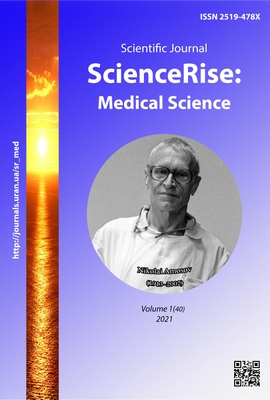Peculiarities of the state of peripheral oxygenation of tissues in different kinds of combined anesthesia in children with congenital surgical pathology
DOI:
https://doi.org/10.15587/2519-4798.2021.224662Keywords:
newborns, infants, congenital malformations, combined anesthesia, pulse oximetryAbstract
In the presented work, we have assessed the features of peripheral oxygenation in children with congenital malformations of the surgical profile under various types of combined anesthesia.
The aim of the study. To assess the state of peripheral oxygenation in newborns and infants with congenital malformations with various types of anesthetic support.
Materials and research methods. A retrospective study included 150 newborns and infants with congenital malformations of the surgical profile, depending on the anesthesia (inhalation + regional anesthesia; inhalation + intravenous anesthesia and total intravenous). The parameters of pulse oximetry were analyzed: peripheral oxygenation, heart rate. Additionally, the concentration of oxygen in the respiratory mixture of children was taken into account.
Research results. Peripheral saturation did not critically decrease at all stages of observation, with the exception of a decrease in the indicator in children of group I compared with group III at the stage of induction into anesthesia (97.79±2.45 versus 98.79±1.63, at p˂0.05, respectively) and at the most painful moment of the operation (96.29±3.47 versus 98.10±2.47, with p˂0.05). At the painful moment of the operation, it was in children of group I that a drop in heart rate was noted compared to group III (127.98±13.77 and 136.10±15.37, respectively, with p˂0.05) and group II (134.02±18.43, at p>0.05) against the background of a decrease in SpO2. Newborns and group I infants required higher oxygen concentrations in the breathing mixture. A significant difference in the indicator is noted between groups I and III at the traumatic stage – 0.47±0.29 and 0.33±0.2, with p˂0.05, respectively, and immediately after the operation – 0.34±0,19 and 0.26±0.13, with p˂0.05, respectively.
Conclusions. The expediency and effectiveness of pulse oximetry for children with congenital malformations at all stages of anesthetic support during surgical treatment was confirmed. The risk group for the formation of oxygen deficiency in organs and tissues, the occurrence of pain during the operation were newborns and infants, for whom combined anesthesia was chosen in the form of an inhalation method and regional anesthesia. In the case of the appointment of this type of anesthetic support, it is necessary to more closely monitor the indicators and promptly correct the deterioration of the child's condition
References
Horbatiuk, O. M. (2011). Suchasnyi stan khirurhii novonarodzhenykh v Ukraini ta perspektyvy rozvytku. Neonatolohiia, khirurhiia ta perynatalna medytsyna, 1, 17–20. Available at: http://nbuv.gov.ua/UJRN/Nkhpm_2011_1_1_5
Shankar, K. R., Brown, D., Hughes, J., Lamont, G. L., Losty, P. D., Lloyd, D. A., van Saene, H. K. F. (2001). Classification and risk-factor analysis of infections in a surgical neonatal unit. Journal of Pediatric Surgery, 36 (2), 276–281. doi: http://doi.org/10.1053/jpsu.2001.20688
Bednarczyk, D., Makowska, I., Sasiadek, M. M., Smigiel, R. (2014). Somatic Mosaicism in Esophageal Atresia. American Journal of Gastroenterology, 109 (12), 1954–1956. doi: http://doi.org/10.1038/ajg.2014.346
Ziyaeifard, M., Azarfarin, R., Azarfarin, R. (2014). New aspects of anesthetic management in congenital heart disease “common arterial trunk”. Journal of research in medical sciences, 19 (4), 368–374.
Stenson, B., Brocklehurst, P., Tarnow-Mordi, W. (2011). Increased 36-Week Survival with High Oxygen Saturation Target in Extremely Preterm Infants. New England Journal of Medicine, 364 (17), 1680–1682. doi: http://doi.org/10.1056/nejmc1101319
Carlo, W. A., Finer, N. N., Walsh, M. C., Rich, W., Gantz, M. G., Laptook, A. R. (2010). Target Ranges of Oxygen Saturation in Extremely Preterm Infants. New England Journal of Medicine, 362 (21), 1959–1969. doi: http://doi.org/10.1056/nejmoa0911781
Schmidt, B., Whyte, R. K., Asztalos, E. V., Moddemann, D., Poets, C., Rabi, Y. et. al. (2013). Effects of Targeting Higher vs Lower Arterial Oxygen Saturations on Death or Disability in Extremely Preterm Infants. JAMA, 309 (20), 2111–2120. doi: http://doi.org/10.1001/jama.2013.5555
Poets, C. F. (2019). Noninvasive Monitoring and Assessment of Oxygenation in Infants. Clinics in Perinatology, 46 (3), 417–433. doi: http://doi.org/10.1016/j.clp.2019.05.010
Znamenska, T. K., Antypkin, Yu. H., Ariaiev, M. L. et. al.; Znamenska, T. K. (Ed.) (2020). Neonatolohiia. Vol. 2. Lviv: Vydavets Marchenko T. V., 40–141.
Plana, M. N., Zamora, J., Suresh, G., Fernandez-Pineda, L., Thangaratinam, S., Ewer, A. K. (2018). Pulse oximetry screening for critical congenital heart defects. Cochrane Database of Systematic Reviews, 3 (3), CD011912. doi: http://doi.org/10.1002/14651858.cd011912.pub2
Downloads
Published
How to Cite
Issue
Section
License
Copyright (c) 2021 Алексей Александрович Власов

This work is licensed under a Creative Commons Attribution 4.0 International License.
Our journal abides by the Creative Commons CC BY copyright rights and permissions for open access journals.
Authors, who are published in this journal, agree to the following conditions:
1. The authors reserve the right to authorship of the work and pass the first publication right of this work to the journal under the terms of a Creative Commons CC BY, which allows others to freely distribute the published research with the obligatory reference to the authors of the original work and the first publication of the work in this journal.
2. The authors have the right to conclude separate supplement agreements that relate to non-exclusive work distribution in the form in which it has been published by the journal (for example, to upload the work to the online storage of the journal or publish it as part of a monograph), provided that the reference to the first publication of the work in this journal is included.









